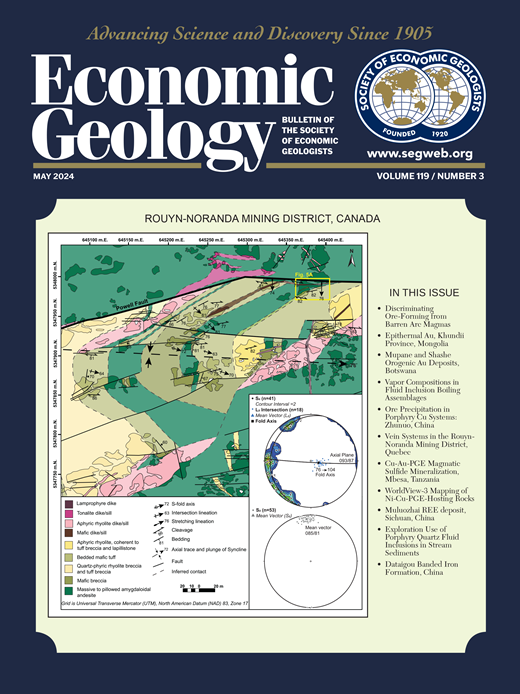蒙古西南部新兴昆迭成矿省的热液金矿发现
IF 4.9
1区 地球科学
Q1 GEOCHEMISTRY & GEOPHYSICS
引用次数: 0
摘要
自 2005 年以来,公司在蒙古西南部一个以前勘探不足的地区进行了矿产勘探,确定了 Zuun Mod 斑岩型钼铜矿床,随后又发现了 Altan Nar 和 Bayan Khundii 热液型金矿床以及几个远景和高级勘探项目。这些发现构成了正在形成的昆迪("山谷")金属成矿省的核心,该金属成矿省面积约为 50 × 100 千米,位于中石炭纪至早二叠纪的单一岛弧地层内,主要位于一个单独测绘的次地层内。该省位于泥盆纪晚期奥尤陶勒盖斑岩型铜金矿床西北偏西约 700 公里处,地处中古生代岛弧带,是中亚造山带的一部分,拥有世界级的斑岩型铜金矿床和表生金矿床,从蒙古南部一直向西延伸到中国、哈萨克斯坦等地。Zuun Mod斑岩型钼铜矿床(297 ± 4.8 Ma)位于花岗闪长岩侵入体上,被B型石英-钼矿-黄铜矿脉切割,该矿脉具有K-长石蚀变边沿以及散布的生物黄铁矿和磁铁矿。在确定该矿床后,基于该地区勘探不足的特点,于 2009 年启动了一项区域勘探计划,勘探面积达 110,000 平方公里。勘探工作包括汇编现有的地质、地球化学和地球物理数据,解读卫星图像,然后进行地面勘探,包括溪流、土壤和岩屑取样以及地质和蚀变绘图。诺明塔尔铜金矿探矿权发现于 2011 年初,根据最初土壤取样的迹象,在勘探许可证南部地区进行了 400 × 400 米的土壤调查,在约 1.5 × 约 5.5 千米的区域内发现了土壤中铅、锌和金的异常。2011 年末,在土壤异常区内的第一个钻孔发现了 Altan Nar 金多金属热液矿床,该矿床具有粗晶石英-金刚砂脉(309.7 ± 0.5 Ma)和碳酸钙、镁、锰和铁碳酸盐岩矸石,是贱金属硫化物的产地。随后于 2021 年初宣布发现了 Khar Mori 金矿项目,该项目位于巴彦昆迪以北约 3 公里处,沿一条构造趋势分布。巴彦昆迪伊的热液型石英-金刚砂-金矿脉(336.8 ± 0.5 Ma)具有胶状带,黄铁矿含量较少,并被近端伊利石蚀变包裹。热液矿脉和蚀变覆盖了早期的残余石英和辉绿岩±屌石±透辉石-高岭石等不相关的蚀变类型。同样,哈尔莫里的残留石英和辉绿岩-黝帘石也被包括砷黄铁矿在内的热液矿化所覆盖。在巴彦昆迪西北约 3 公里处的乌兰项目中部,地表普遍存在强烈的石英-白云母-黄铁矿蚀变,包括电气石体和局部铜异常,与附近的残留石英和相关的铝硅酸盐蚀变有关。这些蚀变类型表明,岩帽被侵蚀至底部,暴露出钾长石和磁铁矿以及与斑岩矿床顶部有关的石英-白云母-黄铁矿,目前只有几个探矿钻孔进行了测试。这种与斑岩有关的蚀变(年代不详)在经过严重侵蚀后,被含金的热液矿脉所覆盖。本文章由计算机程序翻译,如有差异,请以英文原文为准。
Epithermal Gold Discoveries in the Emerging Khundii Metallogenic Province, Southwest Mongolia
Mineral exploration since 2005 in a previously underexplored region of southwestern Mongolia resulted in the definition of the Zuun Mod porphyry Mo-Cu deposit, followed by discovery of the Altan Nar and Bayan Khundii epithermal gold deposits along with several prospects and advanced exploration projects. These discoveries form the core of the emerging Khundii (“Valley”) metallogenic province, ~50 × 100 km in size, located within a single island-arc terrane of Middle Carboniferous to early Permian age and predominantly within an individual mapped subterrane. The province is situated ~700 km west-northwest of the late Devonian Oyu Tolgoi porphyry Cu-Au deposit in a belt of mid-Paleozoic island arcs that are part of the Central Asian orogenic belt, host to world-class porphyry Cu-Au and epithermal gold deposits that stretch from southern Mongolia to the west, into China, Kazakhstan, and beyond.The Zuun Mod porphyry Mo-Cu deposit (297 ± 4.8 Ma) is hosted by a granodiorite intrusion cut by B-type quartz-molybdenite-chalcopyrite veins with K-feldspar alteration selvages plus disseminated biotite and magnetite. After definition of this deposit, a regional exploration program was initiated in 2009 over 110,000 km2, based on the underexplored nature of the region. Exploration included compilation of existing geologic, geochemical, and geophysical data and interpretation of satellite imagery followed by ground exploration that included stream, soil, and rock-chip sampling and geologic and alteration mapping. The Nomin Tal Cu-Au prospect was discovered in early 2011, and based on the indications from initial soil sampling, a 400- × 400-m soil survey was conducted over the southern part of the exploration license, which identified a Pb-, Zn-, and Au-in-soil anomaly over an area of ~1.5 × ~5.5 km. The first drill hole within the soil anomaly in late 2011 resulted in the discovery of the Altan Nar Au-polymetallic epithermal deposit with veins of coarsely crystalline quartz-adularia (309.7 ± 0.5 Ma) and Ca-, Mg-, Mn-, and Fe-carbonate gangue that host the base metal sulfides.The Bayan Khundii gold deposit was discovered in 2015 as the result of prospecting, ~16 km southeast of Altan Nar. Subsequent discovery of the Khar Mori gold project was announced in early 2021, ~3 km north of Bayan Khundii along a structural trend, and later in 2021 drilling discovered wide zones of disseminated gold at Ulaan Southeast, ~800 m west of Bayan Khundii. The epithermal quartz-adularia-gold veins (336.8 ± 0.5 Ma) at Bayan Khundii have colloform bands with minor pyrite and are enveloped by proximal illite alteration. The epithermal veins and alteration overprint an earlier, unrelated alteration style of residual quartz and pyrophyllite ± dickite ± diaspore-kaolinite. Similarly, residual quartz and pyrophyllite-dickite at Khar Mori are overprinted by epithermal mineralization, including arsenopyrite. At the central Ulaan project, ~3 km northwest of Bayan Khundii, intense quartz-white mica-pyrite alteration is widespread at surface, including tourmaline bodies and local copper anomalies, associated with nearby residual quartz and related aluminosilicate alteration. These alteration styles indicate erosion of a lithocap to its base, exposing K-feldspar and magnetite plus quartz-white mica-pyrite related to the top of a porphyry deposit, as yet only tested by a few scout drill holes. The undated porphyry-related alteration was subsequently overprinted by the gold-bearing epithermal veins after significant erosion.
求助全文
通过发布文献求助,成功后即可免费获取论文全文。
去求助
来源期刊

Economic Geology
地学-地球化学与地球物理
CiteScore
10.00
自引率
6.90%
发文量
120
审稿时长
6 months
期刊介绍:
The journal, now published semi-quarterly, was first published in 1905 by the Economic Geology Publishing Company (PUBCO), a not-for-profit company established for the purpose of publishing a periodical devoted to economic geology. On the founding of SEG in 1920, a cooperative arrangement between PUBCO and SEG made the journal the official organ of the Society, and PUBCO agreed to carry the Society''s name on the front cover under the heading "Bulletin of the Society of Economic Geologists". PUBCO and SEG continued to operate as cooperating but separate entities until 2001, when the Board of Directors of PUBCO and the Council of SEG, by unanimous consent, approved a formal agreement of merger. The former activities of the PUBCO Board of Directors are now carried out by a Publications Board, a new self-governing unit within SEG.
 求助内容:
求助内容: 应助结果提醒方式:
应助结果提醒方式:


